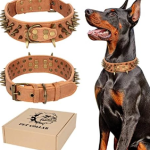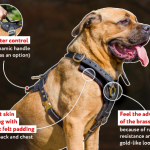Service Dog Vest
When it comes to service dogs, their training and roles are crucial, but so is the equipment they use, particularly the service dog vest. A well-chosen vest not only aids in the effective functioning of a service dog but also ensures that the public recognizes and respects the service animal’s vital role. In this comprehensive guide, we delve into everything you need to know about service dog vests, including their importance, how to choose the right one, and best practices for use.
Understanding the Role of a Service Dog Vest
A service dog vest is more than just a piece of equipment—it’s an essential tool that serves several important functions:
- Identification: The primary function of a service dog vest is to clearly identify the dog as a trained service animal. This identification is crucial in public spaces where pets are generally not allowed. A visible vest helps avoid misunderstandings and ensures that the dog and its handler are not confronted or challenged.
- Functionality: Service dog vests are designed to be functional. They often come with pockets and attachments that can be used to carry essential items like medication, identification cards, or even a water bottle. The design ensures that the vest supports the dog’s working duties effectively.
- Comfort: A well-designed vest ensures that the service dog remains comfortable during long periods of wear. This is important not only for the dog’s well-being but also for maintaining focus and performance in their service tasks.
Key Features of a Service Dog Vest
When selecting a service dog vest, several features need to be considered to ensure it meets both the practical needs of the service dog and the legal requirements. Here are some essential features to look for:
- Adjustability: The vest should be easily adjustable to fit dogs of various sizes and shapes comfortably. Look for vests with adjustable straps and buckles that allow for a secure but comfortable fit.
- Durability: Service dogs often work in diverse environments. The vest should be made from high-quality, durable materials that can withstand various weather conditions and rough handling.
- Visibility: High-visibility vests with reflective materials or bright colors are important for ensuring that the service dog is easily seen in low-light conditions. This feature enhances safety, especially in busy or potentially hazardous areas.
- Comfort: Padding in the vest’s straps and chest area can prevent chafing and discomfort. Breathable materials also help keep the dog cool and comfortable during extended wear.
- Pockets and Attachments: Some vests come with multiple pockets or attachments for carrying necessary items. This can be particularly useful for service dogs that need to carry medication, identification cards, or other essentials.
- Customizability: Personalized vests with custom patches or embroidery can make it easier to identify the specific tasks the service dog performs and provide additional information, such as emergency contact details.
How to Choose the Right Service Dog Vest
Selecting the right service dog vest involves considering several factors. Here’s a step-by-step guide to help you make the best choice:
- Assess Your Dog’s Needs: Consider your service dog’s specific needs and duties. For example, if your dog performs tasks that require carrying items, a vest with multiple pockets may be necessary. For a dog that works in various environments, durability and weather resistance will be critical.
- Measure Your Dog: Accurate measurements are crucial for a good fit. Measure your dog’s girth (the circumference around the widest part of the rib cage) and length (from the base of the neck to the base of the tail). Use these measurements to choose a vest size that fits comfortably without restricting movement.
- Consider the Material: Choose a vest made from high-quality, breathable material. Look for options that offer weather resistance and durability. Common materials include nylon, polyester, and neoprene.
- Check for Adjustability: Ensure that the vest has adjustable straps and buckles. This allows for a custom fit and ensures that the vest can accommodate any changes in your dog’s size or weight.
- Evaluate Visibility Features: Opt for vests with reflective strips or bright colors to enhance visibility. This is especially important if your service dog will be working in low-light conditions or high-traffic areas.
- Look for Comfort Features: Padding and ergonomic design are essential for your dog’s comfort. The vest should fit snugly but not be too tight, and it should have breathable material to prevent overheating.
- Choose a Reputable Supplier: Purchase your service dog vest from a reputable supplier who specializes in service dog gear. This ensures that you receive a high-quality product and can access customer support if needed.
Legal Considerations for Service Dog Vests
Understanding the legal requirements surrounding service dog vests is crucial for ensuring compliance and avoiding potential issues. Here’s what you need to know:
- ADA Regulations: The Americans with Disabilities Act (ADA) does not specifically mandate that service dogs wear vests, but having a vest can help to clearly identify the dog as a service animal. Under the ADA, service dogs are defined as those trained to perform tasks for individuals with disabilities.
- State and Local Laws: Some states or local jurisdictions may have additional regulations regarding the identification of service animals. Check local laws to ensure compliance and to understand any specific requirements for service dog vests.
- Documentation: While the ADA does not require service dogs to wear vests, having documentation such as a certification or ID card can support the identification process and help address any challenges you may face in public spaces.
Best Practices for Using a Service Dog Vest
Proper use and care of a service dog vest are important for both the dog’s comfort and the vest’s longevity. Follow these best practices:
- Regular Inspection: Frequently check the vest for wear and tear. Look for any signs of damage or discomfort, such as frayed straps or loose fittings. Address any issues promptly to ensure the vest remains functional and comfortable.
- Proper Fit: Ensure that the vest fits properly every time you put it on your dog. An ill-fitting vest can cause discomfort or interfere with the dog’s ability to perform its tasks effectively.
- Cleaning and Maintenance: Follow the manufacturer’s instructions for cleaning and maintaining the vest. Regular cleaning helps to keep the vest in good condition and ensures that it remains hygienic for your dog.
- Training: Ensure that your service dog is accustomed to wearing the vest. Proper training can help your dog get used to the vest and minimize any distractions or discomfort.
- Replacement: Over time, vests may wear out or become less effective. Be prepared to replace the vest as needed to ensure that it continues to serve its purpose effectively.
Conclusion
A service dog vest is a vital piece of equipment that serves both functional and identification purposes. Choosing the right vest involves considering factors such as adjustability, durability, visibility, and comfort. By understanding the key features and best practices for using a service dog vest, you can ensure that your service dog performs its tasks effectively and remains comfortable throughout their work.
Whether you are a new service dog handler or have years of experience, investing time in selecting and maintaining the right vest will contribute to the success of your service dog’s role and enhance your interactions in public spaces. With the right vest, you can support your service dog’s essential work and navigate various environments with confidence and ease.






